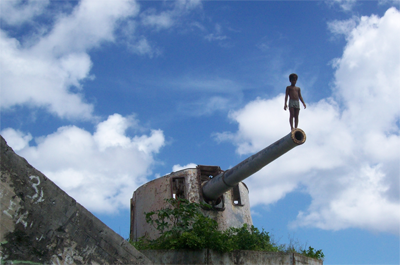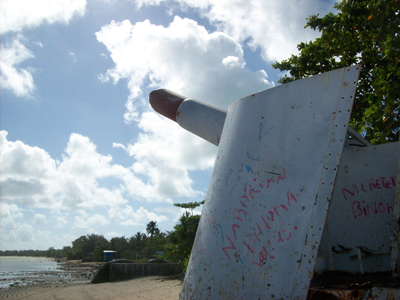
Far to the west from American shores sits the island of Betio, now part of the most populous area of the nation of Kiribati. More than 70 years ago, Betio was a fortress, the site of a Japanese airfield that was the focal point of one of the first amphibious assaults by U.S. Marines in World War II.
While many OSU students were enjoying the summer break, one professor came with a group to this place of golden sands and crystalline waters, where rusted hulks and ancient guns are used by local kids as playground equipment, to help bring home Marines who have called this wounded piece of paradise their final resting place for decades.
Dr. Stephen Perkins, OSU Professor of Anthropology with the Department of Sociology, specializes in cultural anthropology and archaeology, focusing most recently on Oklahoma’s Native peoples.. When a colleague invited him to Kiribati from Lindenwood University, near St. Louis, Mo., Perkins found himself spending three weeks halfway around the world, working in association with the non-profit History Flight, and the Department of Defense POW-MIA Accounting Agency (DPAA).
“In the past, [History Flight] has raised money and then gone out to look for MIAs, specifically focusing on World War II,” Perkins said. “The government has mainly been focused on the MIA issue in Vietnam, probably because Vietnam occurred fairly recently.”
 Betio was the central site for the Battle of Tarawa. For three days beginning Nov. 20, 1943, an estimated 18,000 Marines joined 35,000 American troops in a bid to take a Japanese airfield on the island, the largest in the Tarawa atoll. Despite facing a Japanese garrison consisting of fewer than 5,000 troops and laborers, more than 1,000 Marines and 600 sailors were killed. Only 17 Japanese soldiers and 129 laborers were captured alive.
Betio was the central site for the Battle of Tarawa. For three days beginning Nov. 20, 1943, an estimated 18,000 Marines joined 35,000 American troops in a bid to take a Japanese airfield on the island, the largest in the Tarawa atoll. Despite facing a Japanese garrison consisting of fewer than 5,000 troops and laborers, more than 1,000 Marines and 600 sailors were killed. Only 17 Japanese soldiers and 129 laborers were captured alive.
With 78,000 MIAs still unrecovered on foreign battlefields from WWII, according to Perkins, History Flight invited an anthropology team including Perkins headed by Dr. Steve Dasovich, Professor of Anthropology at Lindenwood, to Betio to search the island for missing American servicemen. With many American and Japanese dead buried temporarily in trench-like mass graves to be recovered later, many of these gravesites were lost in the chaos of the war.
American remains found by the team were turned over to the DPAA for identification at their forensic facility in Honolulu, Hawaii. Japanese remains were turned over to Japanese authorities.
“It was a real honor to be able to go,” Perkins said. “I’ve always been fascinated by World War II, so to be able to go there and actually participate in field work that is helping to repatriate American servicemen is incredibly special to me. I know … it has been very important to a lot of people around the United States.”
Current or future OSU students interested in this kind of work can enroll in the Sociology degree track, which offers both a B.A. and a B.S. option in Anthropology.
For more information on History Flight, visit www.historyflight.com.
A native of Stillwater, Perkins earned his Ph.D. in Anthropology from Arizona State University in 2000, following a B.A. in Anthropology from the University of Oklahoma, and a M.A. in Anthropology from Arizona State.
By: Bryan Trude
